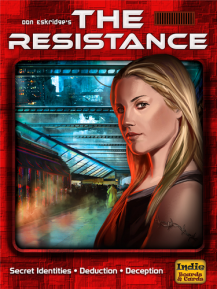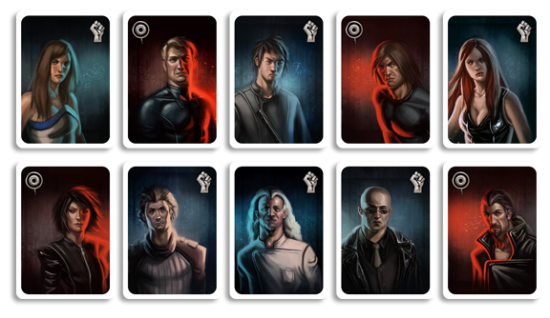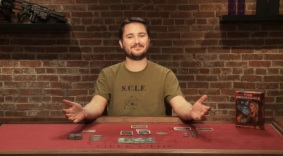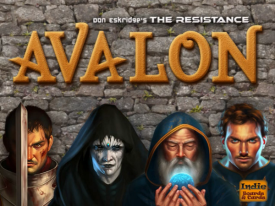The follow up to last week’s Play More Games post
 Don Eskridge’s The Resistance board game has quickly become one of my favorite games…ever. I hesitate to even call it a board game, because nearly the entirety of it is just one tremendous mind game (or headache, depending on who you ask). I discovered The Resistance roughly a month ago and have about 25 games or so under my belt playing with different variants/house rules, sets of players (the game allows 5-10 players), and promo/expansion sets. One of the biggest appeals of the game is that it’s one of the easiest I’ve found to learn, and I’ve never been in a game session where new players didn’t immediately want play another game after being introduced to it.
Don Eskridge’s The Resistance board game has quickly become one of my favorite games…ever. I hesitate to even call it a board game, because nearly the entirety of it is just one tremendous mind game (or headache, depending on who you ask). I discovered The Resistance roughly a month ago and have about 25 games or so under my belt playing with different variants/house rules, sets of players (the game allows 5-10 players), and promo/expansion sets. One of the biggest appeals of the game is that it’s one of the easiest I’ve found to learn, and I’ve never been in a game session where new players didn’t immediately want play another game after being introduced to it.
It’s that good. Here’s a lowdown.
What is The Resistance?

The Resistance is a game set in a Sci-Fi dystopian society with freedom fighters called “The Resistance” working to rebel against a dark and malevolent government. (Think Sarah and John Connor versus Skynet.) The Resistance needs to go on missions to stop this evil government but the group has been infiltrated by enemy spies, sent to sabotage those missions and ultimately, crush the rebel resistance. In the game you get to play as either a loyal operative of The Resistance or a Spy looking to disrupt everything that they stand to achieve.
How to Play The Resistance:

- Each Player receives a facedown Loyalty card that reveals to them whether they are part of The Resistance (Good) or the Spies (Evil).
- The goal of the game is to win three of five Missions in favor of your team.
- Each Mission requires a predetermined number of Players to be chosen. These numbers scale depending on the total number of people in the game.
- After all Players have peeked at their Loyalty cards, a sequence occurs where everyone closes their eyes and all Spies open their eyes to acknowledge one another. In other words, the Spies know the identities of each other and thus, everyone else. The Resistance however, has their eyes closed the entire time and starts off with no definite information besides what they know from their own Loyalty card.
- A Team Leader is randomly chosen out of the pool of players (Leadership rotates clockwise each round from then on) and this person decides the group to go on the current Mission, which may or may not include themselves.
- Players then publicly vote to either “Approve” or “Reject” the group chosen. A majority vote is required but the group is rejected in the case of a tie.
- If a group is rejected, Team Leader shifts to the next position and the process is repeated. (However, if five straight groups for a single Mission are rejected, the Spies automatically win the entire game!)
- Players in an approved group then receive Mission cards labeled “Success” and “Fail.” Each chooses one to play facedown and discards the unused one back into the deck.
- The Resistance MUST vote “Success.” Spies can vote either “Success” or “Fail” in order to suit their evil agenda.
- The Mission cards are shuffled and then revealed one by one. If there is even one “Fail” card, the entire Mission fails. (With one exception depending on Player count) Only if ALL Mission cards are revealed as “Success” does the Mission successfully pass in favor of The Resistance. In either case, the Team Leader shifts, and the next Mission begins.
- At any point in the game, discussion is allowed and encouraged. Once again, the first to secure three of the five Missions for their side wins.
…Sounds easy, right? For a more visual explanation, Wil Wheaton explains the rules and provides a tremendously entertaining playthrough in this TableTop video:
Well now that you know how to play the game, here’s how you really play the game: espionage, lying, subterfuge, deception, finger-pointing, and arguing. And oh, is there arguing. If you’re anything like my group of friends, you’ll have arguing even after the game ends replaying out all the mistakes made, tells missed, and people to blame.
Trust Issues
The Resistance is a social deduction game that follows that age-old Poker adage: “play the players, not the cards.” In fact, it’s one of the purest examples of that I’ve ever seen. You basically cannot win by simply playing the cards because there’s not enough information you can truly be sure of throughout the course of the game. All of a sudden, you find yourself reading small tweaks in body language, contemplating lapses in logic that may or may not be accurate, and looking for tells that out someone’s loyalty – anything that might help you gauge who’s on your side.

This is a game that immediately starts several players off by being able to trust only themselves but at the same time forcibly pushes them into finding a way to trust others by the end. The real game is in the mental journey to reach that conclusion whether it’s developing game theory and logic on the fly and deducing information or going with your gut and acting on a hunch. Either way, you’ll have to ultimately take that leap of faith to convince not only everyone else to think a certain way, but yourself.
Closing Thoughts

From what I’ve noticed, the vanilla game skews a bit towards the Spy team for most player counts, (after all, they are the ones who start out with all the information) but that’s also dependent on who you’re playing with, and how good each individual is at bluffing and convincing others.
But what I love about The Resistance so much is that it’s incredibly versatile and games can be as balanced as you want them to be. In the original set there are optional Plot cards to play during each Mission which can drastically swing the momentum of the game in favor of The Resistance (though I feel these are too random at times). Or, if you pick up the alternate expansion of the game, The Resistance: Avalon (A King Arthurian-themed version of the original), you gain extra Roles that give Players certain abilities to not only help balance games, but also keep them more engaged and alert right from the start. (For example, Oberon is an optional “Spy” Role that makes the person with that particular Loyalty card unknown to the other Evil players.)
Combine these variations with your preconceptions of the behavior of your friends and family playing this game with you and The Resistance becomes the perfect storm of unpredictability and excitement. It will have you second guessing yourself long after the game is over.
Have you played any version of The Resistance? What are your go-to strategies or thoughts on these types of hidden role/traitor social games?

Pingback: My Only 2014 New Year’s Resolution: Play More Games | The Internaut
Well written. I do have several things to add.
Playtime: this depends very much on the how social/vocal of the people playing (as well as how many are playing), but typical games can last from 20 to 45 minutes. Unlike other co-op games like Battlestar Galactica or Shadows over Camelot, which typically last a grueling 2-3 hours only to meet an inevitable demise (the games are skewed towards evil/traitors), Resistance is a lot quicker. This also leads me to my next point of…
Replayability: some games are fun the first few times you play them, but they do get stale after a while. Although I enjoyed playing through such games like Cards Against Humanity, Ticket to Ride, and Race Against the Galaxy the first few times, I have grown tired of them to the point where I probably wouldn’t play them unless someone else wanted to play. I do believe all games have a finite lifespan of playthroughs, but Resistance is one of the few games that have offered such levels of variability that you just want to keep playing. At least that’s how I feel for now. It remains to be seen how I feel through another 10, 20, or even 50 games. A similar game that offers this variability is Dominion.
The only qualm I have with repeated playthroughs (although it’s a minor one), is that more experienced players will have a tendency to approach missions through an “optimal method”. This creates a gap between experienced players and newbies, but this can also be said about any type of game.
One more thing I truly appreciate about Resistance is that everyone’s involved. While other social deduction games like Mafia or Werewolf are engaging, it sucks if you’re one of the first few people eliminated because sitting through until the end of the game can sometimes last an eternity. Resistance and Avalon beautifully eliminates this problem. Everyone is involved, all the time. This ability to cut out the downtime and keep everyone playing is what makes Resistance/Avalon, imo, better than the aforementioned games.
Thanks for the comment! Very good points on all fronts.
Regarding the gap between experienced players and newbies, I am inclined to believe that this “gap” in familiarity is actually a positive (barring a newbie making an illegal move due to not understanding the rules, of course) because it plays right into one of the game’s major themes: unpredictability.
I also agree that board games (but all games in general, really) have that seemingly “finite lifespan” where the max enjoyment typically comes from earlier playthroughs before hitting a point where they become titles you simply stop rushing to pick out of your shelf on game night. Between the optional house rule variants, plot cards, and player roles, The Resistance is a game that offers so much variability when you also factor in the range of personalities playing, the random combination of players on any given team, and the spontaneity of actions and play styles. Just when you think you know what’s going on, you realize you have no idea what’s going on.
It’s controlled chaos in the best possible way.